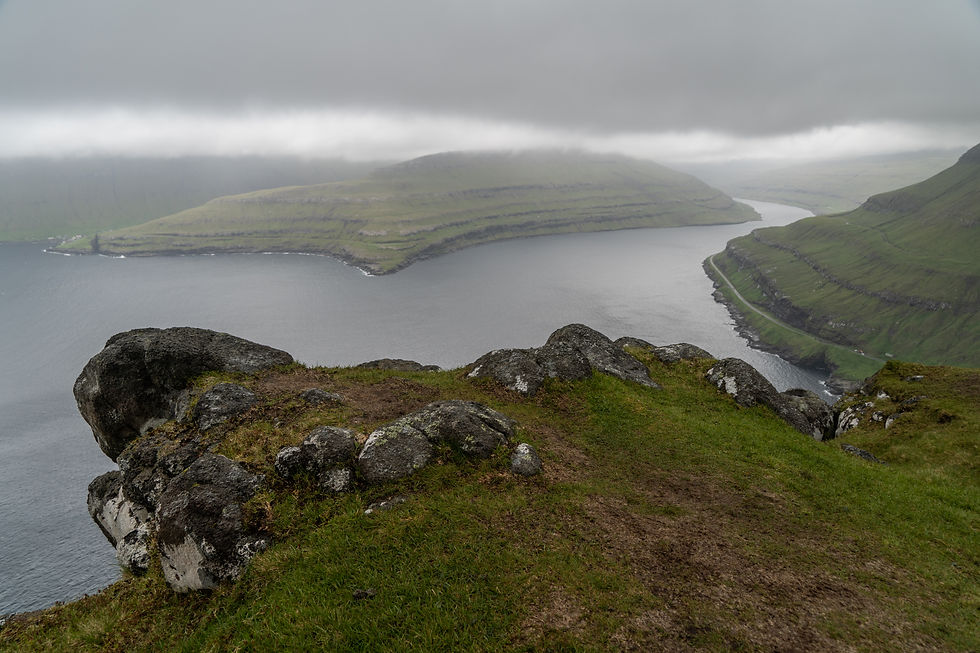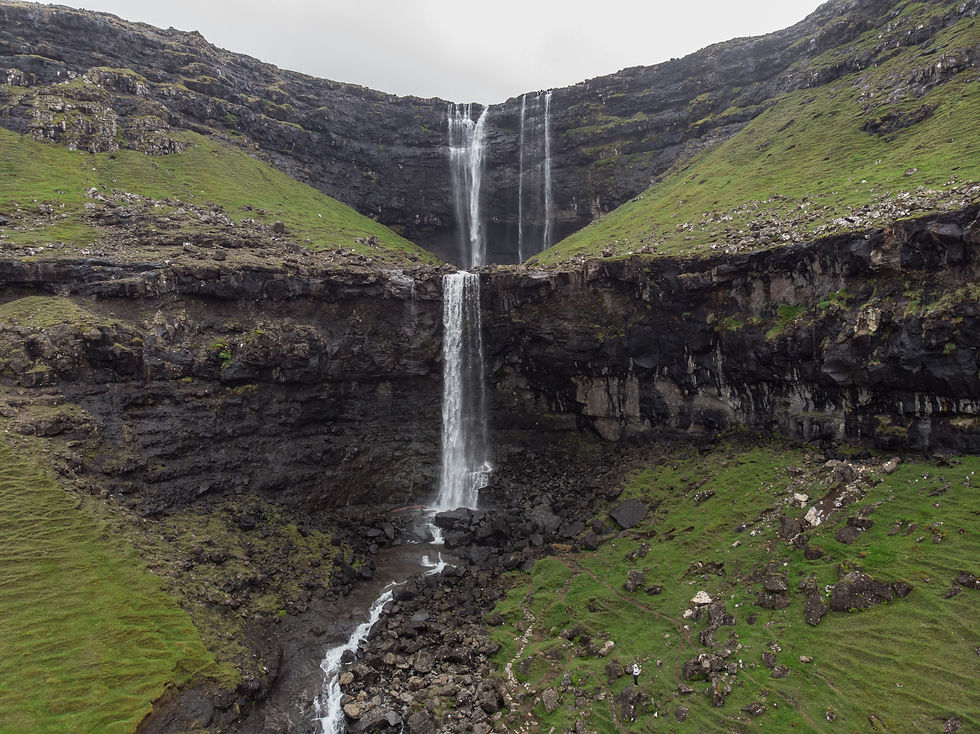Eysturoy & Streymoy
- Our Adventures

- Jun 17, 2024
- 4 min read
travel time: June 2024
Hvithamar / Gøngutúr Trail
When we woke up in the morning, the sky was cloudy, and there was some fog. Nevertheless, the weather was good enough for a small hiking tour. From our guesthouse in Gjógv, we drove along the road until we reached the highest point and parked our car. There is a small ladder to get over the fence, and then you can start the Hvithamar / Gøngutúr Trail. At the trail entrance, there is a sign indicating the route and estimated duration.
As we walked the trail, we encountered quite a bit of muddy grass. Once we reached the edge, we were rewarded with an amazing view that left us speechless.

Eiði & Saksun
After the hike, we drove to the village of Eiði to get a glimpse of the famous football field next to the ocean. For a good view, you can watch it from the road leading down to the village or use a drone.

The old village of Saksun has many original houses with grass roofs overlooking a beautiful lake. Unfortunately, a fence has been erected around the houses this year, but you can still take amazing pictures. If you want to look inside the houses, you need to pay an entrance fee of 150 DKK.
The Fossa Waterfall is the tallest waterfall in the Faroe Islands. Depending on the rainfall, the waterfall can reach up to 30 meters in width.

Tjørnuvík & Elduvík
The road leading to Tjørnuvík becomes quite narrow and eventually turns into a one-way lane regulated by traffic lights. In the tiny village, we wandered around the streets and found a private café listed on Google Maps. Curious about what we would find, we knocked on the closed door and discovered exactly what the map indicated – a private café. A family in this village hosts a café in their home and welcomes visitors with coffee and waffles. It was a delightful experience, and we also got to talk with other travelers.

Driving along a picturesque road, we made our way to Elduvík. It's a small and charming village by the sea, surrounded by steep mountains. Here, you can enjoy unspoiled nature and witness the waves crashing into the natural harbor.
Gjógv
From Gjógv, there are several options for hiking tours. We just wanted to walk up the next hill to get a good view of the village. On the left side of the natural harbor, you can start your walk toward the hill. The path is well marked, and after about 10 minutes, there is a gate where you are kindly asked to pay 50 DKK. You can simply throw the money into a post box and continue your hike. If you don't have any cash, you can also pay online.
From the hill, you have an amazing view of the village of Gjógv, the natural harbor, and the ocean. We didn’t walk the entire trail, but there are two shortcuts that lead you back into the village.
Alex wanted to get an epic view of the village and its charming surroundings, so naturally, he decided to launch the drone. But, this was destined to be the drone’s grand finale. Mid-flight, it did a little (maybe it was a little more than little) wobble — and then it made a dramatic dive towards the ground. After 15 minutes of frantic searching (and a lot of “Did you see where it went?”), we found the poor thing. Have you ever searched for a drone that crashed into grass in a village where even the roofs are made out of grass? Not so funny....
Sadly, it was beyond repair. Rest in pieces, dear drone.

Tórshavn
Tórshavn is one of the smallest capital cities in the world, with about 14,000 inhabitants. We started our city tour in Tinganes, the oldest district in the capital. Here, you find wooden storehouses with grass roofs, which are now home to the Faroese government.
We continued our walk to the harborfront at Vágsbotnur. There, you find many boats and some nice cafés in the old warehouses. As we are always interested in historical sites, we stopped by the Gamli Kirkjugarður, the old graveyard. It’s a green space with trees and many plants between old gravestones. We then wandered through the streets, which led us to Vágsbotn square. There, you find one of the capital’s oldest stores – the atmospheric bookshop, the Faroese parliament, and the city council. Along the main pedestrian shopping street, we continued our walk until we found a charming little coffeehouse.
Outside of the city, we visited the farm Hoyvíkgarður, situated in a beautiful valley in Hoyvík. Here, you can experience an old Faroese farmhouse with its smaller outhouses, barn, and cowshed. To visit the farmhouse, you have to pay an entrance fee, and you receive a detailed explanation of how things were back then. The guide gave us a lot of information and happily answered all our questions. In front of the outhouses, there are QR codes to scan, which tell you the original purpose of each building. We also visited the botanical garden with seasonal Faroese plants.
Before heading to our hotel, we made a quick stop at Svartafoss. It’s a nice green area, but the waterfall is a bit disappointing. We enjoyed the sunshine and took some pictures, but there’s not a lot to see.




















Comments